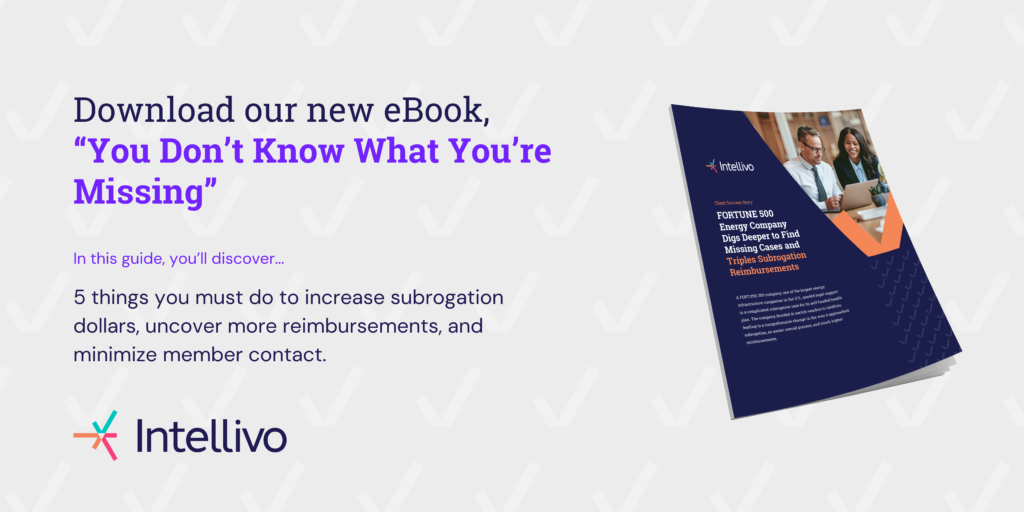As employers seek to offset the rising cost of employee healthcare benefits, subrogation has become a strategic part of cost containment. But traditional subrogation often comes at a price: confusion and complaints from unhappy members.
Speaking at the William Blair Benefit Technology Conference 2025, Intellivo CEO Laura Hescock shared her perspective on this challenge and how a modern, data-driven approach to subrogation can help ensure a seamless health plan member experience while maximizing reimbursements.
“Traditionally, subrogation has been lumped in with other services performed by payers or third-party administrators (TPAs). But for the last 25 years, Intellivo has taken a different approach: giving health plans the option to carve out subrogation and let specialists (that’s us!) handle it,” Laura said in her introduction. “Because of our direct connection to these health plans over the years, we saw that member calls and complaints were the biggest headaches that health plans (not the payer) were experiencing with the typical subrogation process.
“In a typical subrogation process, members will be sent multiple questionnaires and letters asking for additional information about their injuries. This is all because health plans are trying to figure out if their injuries resulted from an accident, and if so, if their claims are eligible for subrogation. Of course, the problem is that members throw the questionnaires in the trash, considering it a scam, and then call in to the health plan after receiving a series of repeated information request letters.
“In modernizing the subrogation process and solving this headache for health plans, we developed our technology that completely eliminates member contact and also ensures the highest financial results. It is a win-win, and honestly, the no-member contact approach has been the biggest driver of our growth, with self-funded health plans carving out subrogation. Over the past few years, we’ve seen TPAs and payers jump on board because they understand how important it is to protect the member experience.
“Today, we’re proud to serve over 200 health plans, including some of the largest TPAs and one out of every four Fortune 100 self-funded companies.”
During the Q&A with moderator Steve Tole, Laura discussed how, with the right data and technology, health plans and TPAs can recover more reimbursements and still deliver a better experience for everyone involved.
Talk about the tension, if it’s fair to call it a tension, between serving two constituents, the employer/health plan, and the ultimate person downstream: the member.
I do think it’s fair to call it a tension, especially when considering the different needs of health plans and their members. Health plans and employers are both focused on keeping costs low. However, this often requires action from the member in the form of responding to subrogation questionnaires, which can be frustrating and burdensome for them. Our experience and our data tell us that most plan members simply never respond to these requests for information that they consider intrusive and unnecessary.
We believe the solution doesn’t have to create tension. Unlike traditional subrogation methods, which require member involvement, our approach eliminates any need for member concern or action. We handle the entire process behind the scenes, finding more reimbursement opportunities and recovering funds from third-party policies or legal claims without ever reaching out to the member. This not only addresses cost containment but also ensures a seamless, stress-free experience for the member.
How have you seen the broker community’s priorities evolve regarding member experience versus cost containment, and how does your platform help brokers deliver on both fronts simultaneously?
We’ve definitely seen a shift in the broker community’s priorities, and I believe this shift is happening simply because there’s now another option.
Historically, subrogation always required member involvement whether filling out forms, answering questionnaires, or providing details about an incident. It was just the way things were done. But once an alternative for no-member disruption became available, it really highlighted how much member aggravation was actually happening with the typical process.
Brokers are now recognizing the value they can bring to health plan clients by delivering both higher financial outcomes and an improved member experience without sacrificing either.
Member experience may not be the first thing people think of when they hear subrogation. How does Intellivo think about not disrupting the member when identifying alternative payment sources?
True, member experience isn’t typically the first thing that comes to mind after the medical costs have already been paid. But member disruption in a post-pay setting can actually be even more disruptive for a plan member.
The challenge with subrogation is that while ICD and CPT codes in paid medical claims can clearly identify the treatment and injury, they don’t always provide information about the cause of the injury. For example, you can see that a member had a fracture, but unless the physician specifically documented the cause of the injury in their notes, which often doesn’t happen, the health plan is left without that crucial detail. Was this a car wreck? Did this happen at work?
This is why questionnaires have traditionally been used—to gather that missing piece of information directly from the member about what happened. However, the problem is twofold:
- Receiving requests for information in the mail is highly unlikely to get a response.
- The member often views the request as a scam, leading to concerns and calls into the plan.
We’ve developed a process that doesn’t involve the member at all. We leverage data from medical claims and numerous third-party data sources such as P&C insurance data, legal documents, police reports, and others to piece together the full picture, including the cause of the injury and the alternative policy information, without ever reaching out to the member.
This allows us to recover funds efficiently while keeping the member’s experience as seamless and stress-free as possible.
How do you address member concerns about data privacy while still leveraging their information to improve care?
We take data privacy very seriously and fully comply with regulations like HIPAA to ensure the protection of member information. Rather than sending member data out, we focus on bringing external data in, such as medical claims, third-party insurance data, legal documents, and police reports.
By cross-referencing this data, we can efficiently identify and recover funds without involving the member or sharing their personal information externally. This approach ensures both data security and optimal outcomes for health plans and members alike.
You Don’t Know What You’re Missing
If you’re a payer or health plan relying on traditional subrogation processes, you’re likely missing out on a significant portion of reimbursement dollars. Read our eBook to learn how to recover more while delivering a better member experience. Download Now

